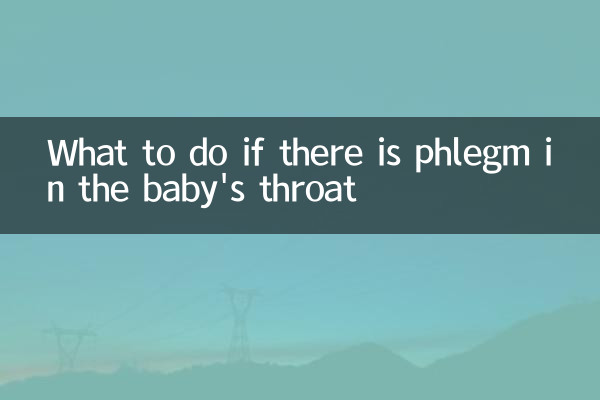What to do if there is phlegm in the baby's throat
Phlegm in the baby's throat is a common problem for many new parents, especially when the seasons change or when colds are most common. Sputum will not only affect the baby's breathing and sleep, but may also cause problems such as coughing and irritability. This article will combine the hot topics and hot content on the Internet in the past 10 days to provide parents with scientific and practical solutions.
1. Common causes of phlegm in babies’ throats

| Reason | Description |
|---|---|
| respiratory tract infection | Viral or bacterial infections such as colds and flu cause increased phlegm secretion |
| allergic reaction | Sensitive reactions to allergens such as dust, pollen, pet dander, etc. |
| Dry environment | Dry air causes the respiratory mucosa to lose moisture and thicken sputum |
| gastroesophageal reflux | Acid reflux irritates the throat and causes phlegm secretion |
2. How to judge whether there is phlegm in the baby's throat
1.Listen to the sound:Grunting or wheezing sounds when breathing
2.Watch for coughs:Frequent dry cough or cough with phlegm sounds
3.Pay attention to your appetite:Reduced milk production due to swallowing discomfort
4.Sleep quality:Easy to wake up and have difficulty breathing, affecting sleep
3. The solution that was hotly debated across the internet within 10 days
| method | Specific operations | Things to note |
|---|---|---|
| Patting on the back to expel phlegm | Hold the baby upright and pat the back gently with your palms in a hollow shape | Avoid the spine, 3-5 minutes each time, 30 minutes after feeding |
| steam inhalation | Put hot water in the bathroom to create steam, hold the baby and inhale it for 5-10 minutes | Pay attention to the water temperature to prevent burns. It should not exceed 15 minutes. |
| saline intranasal drip | Apply 1-2 drops to each nostril, soften the secretions and clean them with a nasal aspirator | Choose baby-specific saline solution and use gentle movements |
| Adjust sleeping position | Raise the head of the bed 30 degrees or lie on your side | Avoid lying prone to avoid risk of suffocation |
| Increase water intake | A small amount of warm water can be fed to breastfed babies over 6 months old. Breastfed babies should be fed more frequently. | The amount of water given each time should not exceed 15ml to avoid affecting the milk supply. |
4. Danger signs to be wary of
1.Shortness of breath:Breathing more than 50 times per minute
2.Purple lips:Symptoms of hypoxia
3.Persistent high fever:Body temperature exceeds 38.5℃ and does not go down
4.Refusal to eat and drink:Not eating for two consecutive meals
5.Listlessness:Sluggish reaction and drowsiness
If any of the above conditions occur, seek medical attention immediately.
5. Suggestions for preventing phlegm accumulation in infants’ throats
| Precautions | Implementation points |
|---|---|
| Maintain appropriate humidity | Use a humidifier to maintain indoor humidity of 50%-60% |
| Ventilate regularly | Open windows for ventilation 2-3 times a day, 15-20 minutes each time |
| Avoid secondhand smoke | Do not smoke around babies |
| Get vaccinated | Get flu vaccine, pneumonia vaccine, etc. on time |
| Dress wisely | Add or remove clothing according to the temperature to avoid overheating and sweating |
6. Special reminder from experts
1.Do not use medicine randomly:Cough medicines are prohibited for infants under 2 years old, and expectorants must be prescribed by a doctor.
2.Use folk remedies with caution:Honey water, scallion water, etc. may cause allergies or indigestion
3.Pay attention to feeding methods:Burp after feeding to avoid choking on milk and aggravating phlegm
4.Regular physical examination:Rule out potential problems such as congenital respiratory dysplasia
Through the above systematic methods, most babies' phlegm problems can be effectively alleviated. Remember, when symptoms persist or worsen, seeking prompt help from a professional pediatrician is the safest option.

check the details

check the details